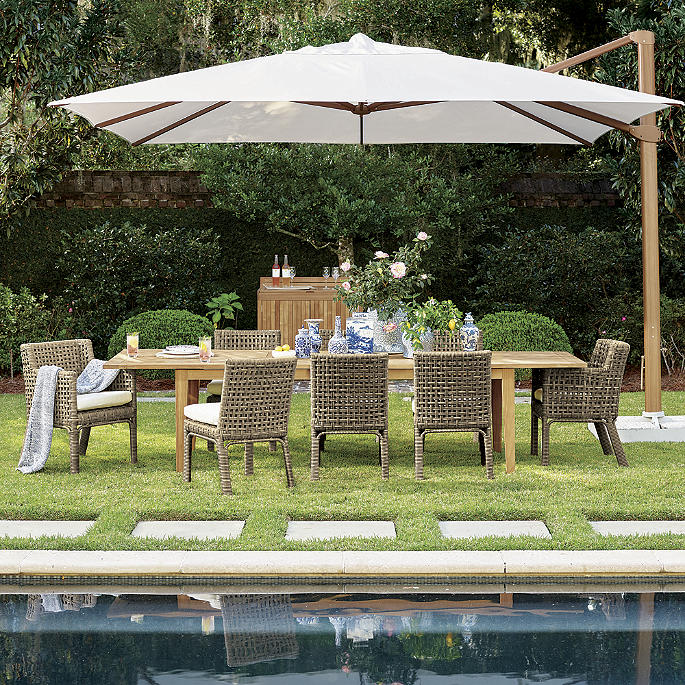Altura Cantilever Umbrella – Indigo Canopy – Frontgate
Oversized aluminum framed umbrella. 100% solution-dyed acrylic canopy fabric resists the damaging effects of sun, mildew and dirt. Lightweight yet sturdy powdercoated aluminum poleAluminum frame with a Silver or a faux-wood, Endura-Teak finish.
Expansive shade and optimal sun protection housed in a compelling architectural design. Colorfast canopy made of solution-dyed fabric. The easy-open crank and 360° swivel rotation make it ideal for optimal coverage throughout the day.
- Oversized aluminum framed umbrella
- 100% solution-dyed acrylic canopy fabric resists the damaging effects of sun, mildew and dirt
- Lightweight yet sturdy powdercoated aluminum poleAluminum frame with a Silver or a faux-wood, Endura-Teak finish
- Endura-Teak finish only on Natural Canopy
- Easy-open crank system
- 360-degree swivel rotation
- Always close umbrella when not in use and in inclement weather
- Base included
- Requires twelve 16″ x 16″ pavers (not included) to stabilize
- Includes a custom cover and pole to assist with covering
- Canopy assembly instructions
- Assembly required
- Imported.
Additional information
| Dimensions | Altura Umbrella (160266): 10' x 13' x 10'H |
|---|






by Jill
This umbrella was recommended by interior designer. It is elegant in design and we love the look and the quality. We purchased the 10 x 13 size. It is important to know for placement of the stand that the post is on the 13′ side. It came with all parts (some of them were tucked inside the packing) and with instructions that made sense. We knew that we would have to purchase 12 concrete blocks 16 x 16″ to hold the stand in place. I asked 3 strong men to help mount the umbrella onto the stand, although 2 of them would have been sufficient.
It is easy to raise and lower the umbrella, although it helps to be tall enough to reach the floating part on the post (I am 5’7″.) It is also helpful to know that you can rotate the umbrella 90 or 180 degrees to allow more room to raise or lower the umbrella so that it does not hit your table or chairs. Now it is winter in San Diego, and it creates the sense of an outdoor living space with out patio heaters, but we are anticipating that it will be even better during the summertime to provide shade and block the sun. It looks as if it can be cantilevered a bit to help with that, so having the post positioned on the west side seems best to help with afternoon sun.
by Jacob
Better than anything else on the market for the price point.
by Monnie
Great amazing quality umbrella. Covers large space. Looks professional. You would see outdoor at a Miami hotel. Take 3 people to set up. Note. Screws and small pieces are hidden in base box. You need to dig for the pieces. They are in the box hidden in the cardboard. Hope to have this umbrella forever!
by Jon
I am very pleased with the quality of the umbrella. I think it will work out great. But the installation was a nightmare, mainly because the installation instructions provide terrible advice. They tell you to first install the adapter (a 3 foot long vertical post with a flange at the bottom that bolts into the base), then lift the umbrella onto the adaptor and slide it down. This might work for a small umbrella, but not for the 11.5 foot model that we got. It’s just way too heavy and unwieldy for this.
After trying to follow their instructions, we finally decided to ignore them and just lifted the post onto the base, with the adaptor locked inside the main column. Once this assembly is upright on the base, one person can hold it place, while the other screws the first two bolts into the base. Once the first two are are in, you can pull the pin that locks the column to the adaptor, so it can rotate, giving you access to the other bolt holes.
One thing to watch out for is that the adaptor holes are not evenly spaced, so there is only one alignment of the adaptor to the base that actually works. Before raising the umbrella, make sure you know how it needs to lines up, and mark it with a piece of masking tape so that you can get the right alignment once it’s positioned on the base.
It takes at least two pretty strong people to do this, and preferably at least one should be tall.
by Patrick
Absolutely love this Cantilever. The quality is impeccable. It looks beautiful. I am constantly getting compliments from my neighbors, family & friends. It took a little longer to arrive because of all the delays in receiving packages.